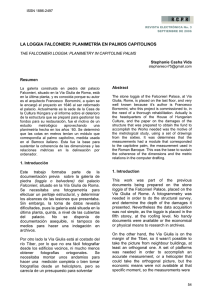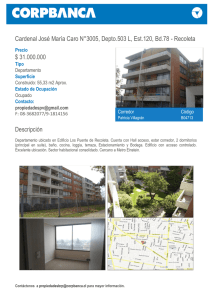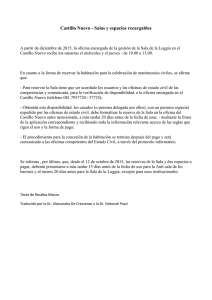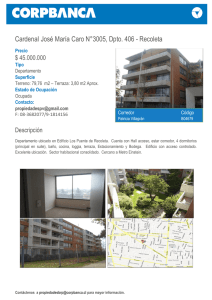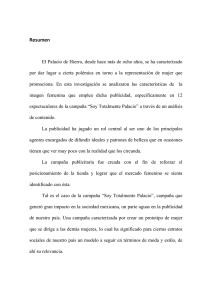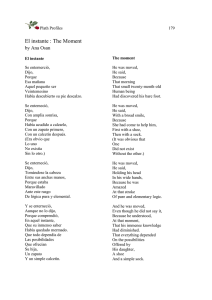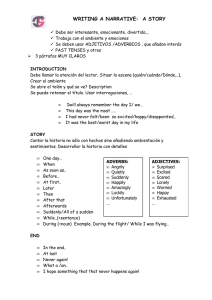3.5. La loggia falconieri - ReCoPaR
Anuncio
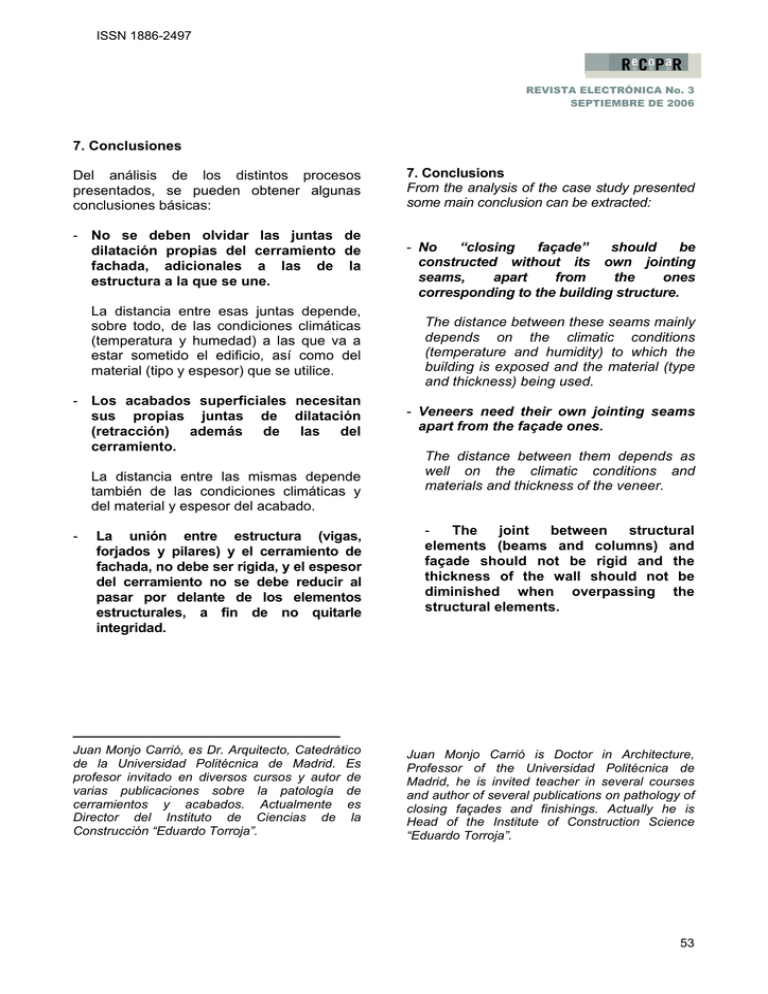
ISSN 1886-2497 REVISTA ELECTRÓNICA No. 3 SEPTIEMBRE DE 2006 7. Conclusiones Del análisis de los distintos procesos presentados, se pueden obtener algunas conclusiones básicas: - No se deben olvidar las juntas de dilatación propias del cerramiento de fachada, adicionales a las de la estructura a la que se une. La distancia entre esas juntas depende, sobre todo, de las condiciones climáticas (temperatura y humedad) a las que va a estar sometido el edificio, así como del material (tipo y espesor) que se utilice. - Los acabados superficiales necesitan sus propias juntas de dilatación (retracción) además de las del cerramiento. La distancia entre las mismas depende también de las condiciones climáticas y del material y espesor del acabado. 7. Conclusions From the analysis of the case study presented some main conclusion can be extracted: - No “closing façade” should be constructed without its own jointing seams, apart from the ones corresponding to the building structure. The distance between these seams mainly depends on the climatic conditions (temperature and humidity) to which the building is exposed and the material (type and thickness) being used. - Veneers need their own jointing seams apart from the façade ones. The distance between them depends as well on the climatic conditions and materials and thickness of the veneer. La unión entre estructura (vigas, forjados y pilares) y el cerramiento de fachada, no debe ser rígida, y el espesor del cerramiento no se debe reducir al pasar por delante de los elementos estructurales, a fin de no quitarle integridad. The joint between structural elements (beams and columns) and façade should not be rigid and the thickness of the wall should not be diminished when overpassing the structural elements. Juan Monjo Carrió, es Dr. Arquitecto, Catedrático de la Universidad Politécnica de Madrid. Es profesor invitado en diversos cursos y autor de varias publicaciones sobre la patología de cerramientos y acabados. Actualmente es Director del Instituto de Ciencias de la Construcción “Eduardo Torroja”. Juan Monjo Carrió is Doctor in Architecture, Professor of the Universidad Politécnica de Madrid, he is invited teacher in several courses and author of several publications on pathology of closing façades and finishings. Actually he is Head of the Institute of Construction Science “Eduardo Torroja”. - 53 ISSN 1886-2497 REVISTA ELECTRÓNICA No. 3 SEPTIEMBRE DE 2006 LA LOGGIA FALCONIERI: PLANIMETRÍA EN PALMOS CAPITOLINOS THE FALCONIERI LOGGIA: PLANIMETRY IN CAPITOLINE PALMS Stephanie Casha Vida [email protected] Resumen La galería construida en piedra del palacio Falconieri, situado en la Via Giulia de Roma, está en la última planta, y es conocida porque su autor es el arquitecto Francesco Borromini, a quien se le encargó el proyecto en 1646 al ser reformado el palacio. Actualmente es la sede de la Casa de la Cultura Húngara y el informe sobre el deterioro de la estructura que se preparó para gestionar los fondos para su restauración, fue el motivo de un estudio metrológico aprovechando una planimetría hecha en los años `60. Se determinó que las cotas en metros tenían un módulo que correspondía al palmo capitolino, medida usada en el Barroco italiano. Esta fue la base para sustentar la coherencia de las dimensiones y las relaciones métricas en la delineación por ordenador. Abstract The stone loggia of the Falconieri Palace, at Via Giulia, Rome, is placed on the last floor, and very well known because it’s author is Francesco Borromini, who this project is commissioned to, in the need of a thorough rehabilitation. Actually is the headquarters of the House of Hungarian Culture, and the paper on the damages of the structure that was prepared to obtain the fund to accomplish the Works needed was the motive of the metrological study, using a set of drawings from the sixties. It was determines that the measurements had a module that corresponded to the capitoline palm, the measurement used in the Roman Baroque. This was the base to sustain the coherence of the dimensions and the metric relations in the computer drafting. 1. Introducción Este trabajo formaba parte de la documentación previa sobre la galería de piedra (loggia o belvedere) del palacio Falconieri, situado en la Vía Giulia de Roma. Se necesitaba una fotogrametría para efectuar un peritaje estructural, y determinar los alcances de las lesiones que presentaba. Sin embargo, la toma de datos revestía dificultades, pues la galería está situada en la última planta, quinta, a nivel de las cubiertas del palacio. No se disponía de documentación asequible, ni tampoco de medios para hacer una indagación en archivos. Por otro lado la Vía Giulia está al costado del río Tiber, por lo que no era fácil fotografiar desde los edificios vecinos, ni mucho menos obtener fotografías ortogonales. Se necesitaba montar unos andamios para hacer una medición completa o bien tomar fotografías desde un helicóptero, pero se carecía de un presupuesto para solventar 1. Introduction This work was part of the previous documents being prepared on the stone loggia of the Falconieri Palace, placed on the Via Giulia of Rome. A fotogrammetry was needed in order to do the structural survey, and determine the depth of the damages it presented. Nevertheless the data acquisition was not simple, as the loggia is placed in the fifth storey, at the roofing level. No handy documents were available or the economical or physical means to research in archives. On the other hand, the Via Giulia is on the margin of the Tiber, so it wasn’t possible to take the picture from neighbour buildings, at least an orthogonal one. A set of platforms was needed in order to accomplish an accurate measurement, or a helicopter that could take the orthogonal picture, but the economic means were not available at that specific moment, so the measurements were 54 ISSN 1886-2497 REVISTA ELECTRÓNICA No. 3 SEPTIEMBRE DE 2006 estos costes. Por lo que las medidas se tomaron desde el interior de la galería y con muchas limitaciones. El informe debía prepararse en breve lapso de tiempo y lo más completo posible, con el fin de que la institución cultural gestionara los fondos ante el Ministerio de Educación húngaro para acometer los estudios definitivos y los futuros trabajos de restauración. taken from the inside of the loggia, and with difficulty. The report needed to be finished in a very short time, as it was required to obtain the funds needed from the Hungarian ministry in order to start the final studies and the future works. 2. Antecedentes históricos 2. Historic Antecedents La construcción del palacio Falconieri se inició en el siglo XVI. Se piensa que es una obra de Antonio Sangallo II (1483-1546), y perteneció en su origen a Atilio y Livia Ceci. Más tarde fue adquirido por Monseñor Paolo Odescalchi, pero dado el estado de conservación del palacio fue necesaria su rehabilitación. Posteriormente fue vendido a la familia Farnese, y finalmente el banquero Orazio Falconieri lo adquirió por medio de derechos de prelación sobre el inmueble al no tener herederos Pietro Farnese di Lattera y su mujer Camilla Virginia Savelli. The construction of the Palazzo Falconieri was started in the sixteenth century, and is taken as a work of Antonio Sangallo (14831546)(not in all texts this fact is supported), and originally belonged to Atilio and Livia Ceci. Later it was acquired by “Monseñor” Paolo Odescalchi, but given the state of conservation of the palace, rehabilitation was needed. Later it was sold to the Farnese Family, and finally the banker Orazio Falconieri acquired it, as Pietro Farnese di Lattera and his wife Camilla Virginia Savelli had no heirs. En el censo de 1635 habitaban en el palacio desde la pascua de ese año, Orazio Falconieri y sus dos hermanos con sus respectivas familias, en total catorce personas. En 1645 Orazio adquierie otra casa situada al norte del palacio y un año después de la adquisición, se encargó al arquitecto Borromini la ampliación y reorganización de ambos edificios. En particular de tres partes significativas del palacio Falconieri: el frente de fachada hacia el lungotevere (avenida de canalización del río hecha posteriormente a la construcción del palacio), la loggia o galería y belvedere o terraza que a continuación se describe (figs. 1, 2 y 3) y cuya planimetría se adjunta, y la decoración de algunas estancias del ala norte. In the 1635 census it is found that from that year’s Easter Orazio Falconieri and his two brothers, with the respective families of the three, in total fourteen people, lived at the palace. In 1645 Orazio acquires the house on the north side of the Palace, and alter that he commissions Borromini the enlargement and reorganization of both buildings. In particular the significative of the Falconieri Palace, the front façade towards the lungotevere, the loggia or altana, which we pass to describe (figs. 1, 2 and 3) and whose planimmetry we enclose, and the decoration of some of the new northern wing rooms. 55 ISSN 1886-2497 REVISTA ELECTRÓNICA No. 3 SEPTIEMBRE DE 2006 3. Descripción de la galería 3. Description of the loggia El carácter de la fachada está dado por las pilastras que se ensanchan en la parte superior para compensar la deformación producida por la perspectiva cónica. Están coronadas por dos esculturas, cada una de ellas tiene el pecho y cabeza de halcón (símbolo de la familia Falconieri) y senos femeninos. La del costado izquierdo fue colocada entre 1730 y 1735. Desde 1650 hasta 1660 se desarrollaron varios trabajos para rehabilitar el palacio: canalizaciones de agua potable, y construcción de graneros, cocinas y jardines. Y desde 1664 a 1669 se llevaron a cabo los acabados y restauraciones interiores. En la documentación consultada, entre 1730 y 1733 figuraba Ferdinando Fuga como arquitecto de la familia Falconieri, quien trabajó además en el edificio adyacente al palacio principal. Entre otros trabajos dirigió la colocación de las cabezas de los halcones en los flancos del edificio. The façade’s character is given by the columns enlarged on the upper side to level the deformation produced by the conic perspective, crowned by two sculptures, each one with the head and chest of a hawk (symbol of the Falconieri family) and female breasts. The one on the left side was placed between 1730 and 1735. From 1650 to 1660 several works for the rehabilitation of the palace took place, drinking water plumbing, the construction of barns, kitchens and gardens. From 1664 to 1669 the finishing and restoration of inner decorations took place. After Borromini between 1730 and 1733, according to the consulted documents Ferdinando Fuga appears as the Falconieri family architect, who also worked in the contiguous building. Among other works he directed the placing of the hawk heads on the sides of the building. Respecto a la galería que es la pieza que identifica al palacio, está situada en el ala sur, con accesos laterales y un pequeño espacio trasero que conduce a las habitaciones, la galería misma (fig. 4) y un acceso a la parte superior, es decir al belvedere. Dicha galería se asemeja proporcional y estilísticamente a la de Giacomo Della Porta, situada en la fachada trasera del palacio Farnese, que colinda con el Falconieri. El trazado de los extremos laterales de la galería es en base a curvas cóncavas. Aparentemente fue un desafío para Borromini, y aunque las proporciones son similares, la enriquece al introducir una serie de variaciones que le confieren un movimiento del que carece la traza académica de la loggia de Della Porta con la cual de alguna forma competía. Las columnas de soporte del entablamento dividen el plano en tres vanos de carácter serliano, en los que se insertan los arcos, de tal manera que se superponen Relating to the loggia, this is the architectonic piece that identifies the palace. It is located on the southern wing, with lateral access and a small hind space that takes to the rooms, the loggia itself (fig. 4) and an access to the terrace (altana), the upper part of the loggia. This loggia is close in proportion and style to the one by Giacomo Della Porta, on the posterior façade of the Farnese Palace, contiguous to Falconieri. The outline of the sides of the gallery is based on concave curves. Apparently it was a challenge for Borromini, and though the proportions are similar, it is enriched by the introduction of a series of variations that endow it with a movement that the academic trace of his competitor, Della Porta lacks. The columns that support the entablature divide the plain in three openings of serlian character, in which the arches are inserted in a way in which two compositive modules are overlaid by the difference of the heights among the columns which here we name tall and short (figs. 5, 7 and 8). 56 ISSN 1886-2497 REVISTA ELECTRÓNICA No. 3 SEPTIEMBRE DE 2006 dos módulos compositivos por la diferencia de alturas de las columnas que aquí se señalan como altas y bajas (figs. 5, 7 y 8). El belvedere (fig. 6 y 12) está rodeado por una balaustrada perimetral coronada por ocho bustos de piedra, todos diferentes, de Hermes o Jano Bifronte (1), en una alternancia de faces femeninas y masculinas, tanto en el lado exterior como en el lado interior de la misma. Se accede mediante una pequeña escalera metálica. Teniendo en cuenta que la galería es un cuerpo añadido, y que presentaba fisuras, la comparación de las medidas modernas en relación a las usadas en su construcción, podía proporcionar más información sobre su posible inestabilidad. Por otro lado, hay que agregar que los análisis petrológicos arrojaban una acusada pérdida de cohesión del material de las esculturas de Jano bifronte (fig. 9, 10 y 11), dadas las condiciones más desfavorables de exposición ambiental. La disgregación y rotura de la piedra eran evidentes en la toma de muestras y confirmada por los resultados de laboratorio. 4. La metrología como instrumento de comprobación: el palmo capitolino La documentación existente estaba constituida por una serie de planos de excelente calidad levantados en los años ‘60 (en base a una medición directa o documentación más amplia). Además de unas breves referencias gráficas recogidas en un compendio editado por la institución que ocupa dicho palacio. Se contaba también con fotografías tomadas desde el nivel de la calle y desde el otro lado del Tiber, que tenían las deformaciones previsibles y un formato que no se adaptaba a los propósitos de estudio, excepto para comprobar proporciones. Examinando además dibujos antiguos, no los del levantamiento de los años ’60 sino los de The terrace or altana (fig. 6 and 12) is surrounded by a balustrade crowned by eight stone sculptures of Hermes or Janus Bifrons (1), in an alternance of feminine and masculine faces in the exterior an interior of it, and which can be reached by a small metallic staircase. Knowing that the loggia is an added body, and one presenting fissures, the comparison between the nowadays measurements in relation to those used in its construction could give us information on its possible instability. On the other hand we have to add that the geological surveys showed and accused loss in the cohesion of the stone in the sculptures of Janus (figs. 9, 10 y 11), given the most unfavourable conditions of external exposure. The dispersion and fracture of the stone were evident in the sampling and confirmed in the laboratory. 4. Metrology as a verifying instrument, the capitoline palm The documents we had, consisting in a series of drawings of excellent quality, drafted in the sixties (based on a direct measurement and probable ampler graphic documents), added to brief graphic references collected by an edition of the institution housed in the palace nowadays (being the Hungarian culture house in Rome). We also had photographs taken from the street level and from the other margin of the Tiber, with the expected deformations and a format that couldn’t be adapted to the purpose of the study, except to verify proportions. Also, examining old pictures, not the ones from the sixties, but other Works by the author (“Borromini” by Paolo Portoghesi), the measurement unit used during the Baroque was the capitoline palm, corresponding to fourth part ¼ o a capitoline foot used in ancient Rome. 57 ISSN 1886-2497 REVISTA ELECTRÓNICA No. 3 SEPTIEMBRE DE 2006 otras obras del autor (“Borromini” por Paolo Portoghesi), la medida utilizada en el Barroco era el palmo capitolino, que corresponde a la ¼ parte de un pie capitolino usado en la antigua Roma, y equivale a 0.07392 m (2). De origen antropométrico, establece relaciones exactas según el sistema sexagesimal, y se utilizaba desde los tiempos del imperio sirio. El estudio metrológico constituyó por consiguiente parte del trabajo para conocer la posibles equivalencias al sistema métrico decimal (3). This is 0.07392 m (2) (the capitoline foot is 0.2957m). Of an anthropometric origin, it establishes exact relations according to the sexagesimal and used at the time of the Syrian Empire. The metrologic study therefore became a part of the study and search for equivalence with the decimal metric system (3). 5. Verifying the measures. 5. Verificación de las medidas La delineación en Autocad de los planos existentes, sirvió para comprobar la razón métrica del levantamiento, es decir, la medida original que se usó en la construcción de la loggia. Cabe señalar que los planos de partida estaban acotados y dibujados en metros y centímetros, pero no con una exactitud en mm pues se había redondeado las medidas a 0 ó 5. Al superponer los palmos capitolinos a estas medidas y a las que se tomaron directamente con el fin de verificarlas, las diferencias eran de unos pocos centímetros cuando las había, lo cual confirmaba que se había contado con andamios en el levantamiento de los ‘60. La comparación de las medidas permitió concluir sin lugar a dudas, que la galería diseñada por Borromini, está proyectada en su totalidad en palmos más que en pies capitolinos, ya que la primera medida constituye el módulo individual que permite encontrar coherencias, fiabilidad y lógica en las relaciones métricas. A continuación se indican las medidas de algunos elementos arquitectónicos, todas en palmos capitolinos: Planta de la loggia: 59 x 182 (largo por ancho) Altura de base de columnas altas: 12 palmos Altura del fuste de columnas altas: 59 palmos Diámetro de columnas altas: 7 palmos Altura del entablamento: (h total) 24 palmos Altura de base de columnas bajas: 3 palmos Altura de fuste de columnas bajas: 24 palmos The Autocad drafting was useful to compare the metric ratio of the drawings, being, the original set of measures used in the construction of the loggia. We must add that the drawings from which we started were measured and drawn in meters and centimetres, but rounded in mm, to 0 or 5. When capitoline palms were overlaid to these measurements, and to the ones we took to verify, the differences were a few centimetres when such existed, and that confirmed that the drawings and previous measurements were taken physically with platforms. Also comparing the measurements we saw that the loggia was in fact built in capitoline palms, rather than in capitoline feet, as the palms constitute the individual module that allows to establish coherence, trust and logic in metric relations or ratios. To continue we show the measures of some architectonic measurements, all in capitoline palms: Floor Plan: 59 x 182 (length x width) Height of the base, tall columns: 12 palms Height of the shaft, tall column: 59 palms Diameter, tall columns: 7 palms Height of the entablature: (total h.) 24 palms Height of the base, short columns: 3 palms Height of the shaft, short column: 24 palms 58 ISSN 1886-2497 REVISTA ELECTRÓNICA No. 3 SEPTIEMBRE DE 2006 Diámetro de columnas bajas: 5 palmos Altura de capitel de columna baja: 8 palmos Altura de imposta:7 palmos Flecha de arco:18 palmos Luz de arco: 32 palmos Altura del antepecho de balaustrada: 4 palmos Altura de balaustrada: 13 palmos Jano bifronte: 10x10x10 (sólido capaz) Diameter, short columns: 5 palms Height of capital, short column: 8 palms Height of the impost: 7 palms Spring Line: 18 palms Span of the arch: 32 palms Height of the parapet of the balustrade: 4 palms Height of the balustrade: 13 palms Janus Bifrons: 10 x 10 x10 (block) Por lo expuesto, la planimetría preparada sirvió de base para preparar la documentación requerida, sin que reemplazara al levantamiento fotogramétrico. As we expose, the draftings prepared served to elaborate the needed documents, but never replacing the fotogrammetry. 6. Conclusions 6. Conclusiones La metrología es un aspecto a tener en cuenta en la elaboración del estado del arte de un edificio antiguo pues el módulo métrico forma parte del legado del proyecto. Es una herramienta de soporte y de corrección técnica, tanto en el levantamiento planimétrico como en la descripción de elementos constructivos y ornamentales. Su aplicación es muy sencilla si se conoce el sistema de medidas utilizado para comprobar la exactitud de una planimetría, incluso sino se cuenta con los andamios o medios necesarios, como en el caso de la galería del palacio Falconieri, más aún si no es posible la presencia física en el sitio. También sirve para comprobar la procedencia de los autores o constructores, los antecedentes, proporciones y traza original. El estudio de los sistemas de medidas antiguos permite construir una malla de referencia, para insertar detalles, lesiones y otros datos, incluso si solamente se conocen sus proporciones. De esta serie de tramas se obtendría más información añadida a la se puede obtener visualmente o en la medición directa. Metrology is an aspect to take in consideration in the elaboration of a state of the art of an old building, as the measurement module is a part of the legacy of the project. It is a support tool of technical correctness, in collecting the data as in the description of ornamental elements. The application is very simple if you know the system of measures used to verify the accuracy of a set of drawings, if the means are meagre as in the case of the Falconieri loggia, even more if physical presence is not possible. It is also very useful to verify the birthplace or origin of the authors or constructors, antecedents, proportions and original tracings. The study of ancient systems of measures allows the building of a net of references that accepts the insertion of details, damages and other information, even if you only are in the position to work with the proportions. Out of this collection or weft, of nets we can obtain much more information than the one available to the naked eye or in direct measurement. 59 ISSN 1886-2497 REVISTA ELECTRÓNICA No. 3 SEPTIEMBRE DE 2006 Notas: 1. Jano Bifronte en la antigua Roma era el dios encargado de las puertas, de las entradas y las salidas, además es el guardián del clima y las cosechas. Cada una de estas efigies tiene un rostro distinto, tanto el femenino como el masculino. 2. “El pie se define como la sexta parte del cuerpo humano (la braza o el estado) y éste a su vez se divide en doce partes dando lugar a la pulgada”. Tratado de Rehabilitación, tomo 2, “Planimetría y Metrología en las Catedrales Españolas” por José Merino de Cáceres. 3. Equivalencias: Pie Capitolino: 0.2957 m Palmo Capitolino: 0,0739 m Palmipes (mano): 0,3696 m (1,25 pies) Agradecimientos: Arq. Paolo Scialanca, director técnico a cargo de la restauración de la loggia. Las fotografías han sido facilitadas por el arquitecto Peter Klanitzcay, quien en 2003 era el Vicedirector de la Oficina para el Patrimonio Cultural Húngaro. Stephanie Casha Vida es arquitecto, y hace el doctorado en la Escuela Técnica Superior de Arquitectura de Madrid. Este es un trabajo predoctoral realizado durante su estancia en Roma. Notes: 1. Janus Bifrons in ancient Rome was the god that controlled the doors, the entrances, the exits, as the guardian of the climate and the harvest. Each of these effigies has a totally different faces, the masculine and the feminine one. (rel. to Hermes) 2. “The foot is defined as the sixth part of the human body (fathom) and this one is divided in twelve parts producing an inch” Treatise of Rehabilitation, volume 2, “Planimetry and Metrology in Spanish Cathedrals” by José Merino de Cáceres. 3. Equivalences: Capitoline Foot: Capitolino: 0.2957 m Capitoline Palm: 0.0739 m “Palmipes”(hand): 0,3696 m (1,25 feet) Acknowledgements: Arch. Paolo Scialanca, technical director in charge of the restoration of the loggia. The photographs have been supplied by arch. Peter Klanitzcay, who in 2003 was Vice-director of the Office for Hungarian Cultural Patrimony. Stephanie Casha Vida arch. Is currently acquiring doctorate degree at the Escuela Técnica Superior de Arquitectura de Madrid. This is a predoctorate paper fulfilled during her dwelling at Rome. Fig 1 Palacio Falconieri, fotografía desde la otra orilla del Tiber. Falconieri Palace, picture taken the opposite shore of Tiber river 60 ISSN 1886-2497 REVISTA ELECTRÓNICA No. 3 SEPTIEMBRE DE 2006 Fig. 2 Loggia Fig. 3 Entorno del Palacio Falconieri, en el centro hacia la derecha Surrounding of Falconieri Palace, (centre towards the right) 61 ISSN 1886-2497 ISSN 1886-2497 ISSN 1886-2497 ISSN 1886-2497 REVISTA ELECTRÓNICA No. 3 SEPTIEMBRE DE 2006 Figs. 9, 10 y 11. Bustos de piedra de Hermes o Jano bifronte. Stone sculptures of Hermes or Janus Bifrons Fig 12. Extremo concavo del belvedere. Concave extreme of terrace. 64
